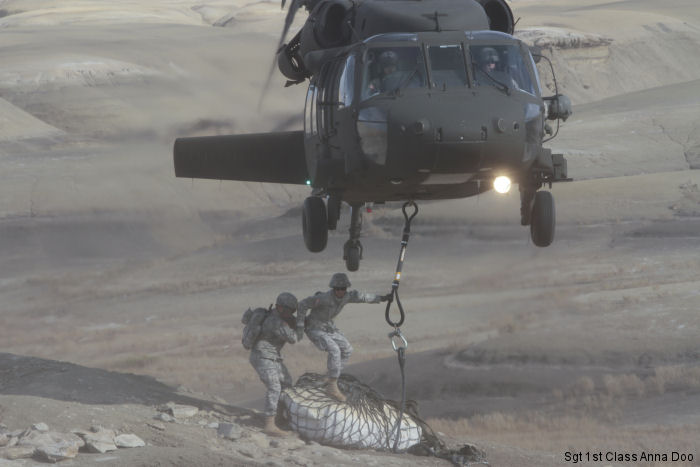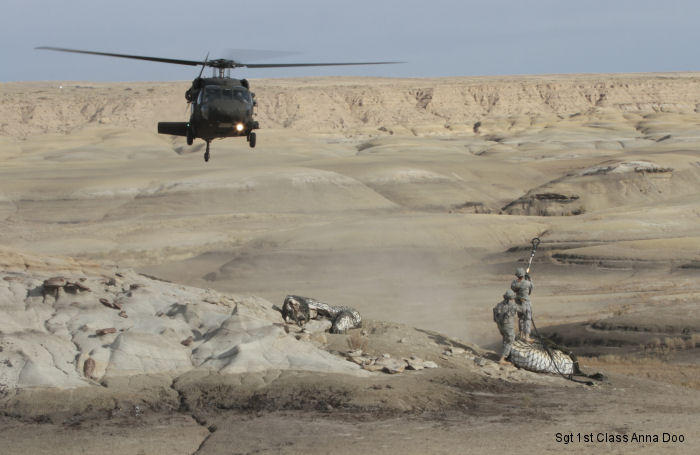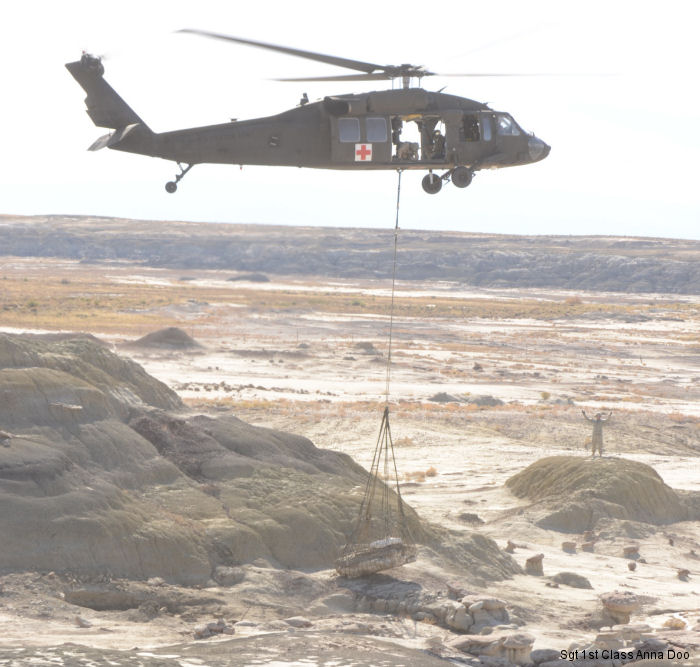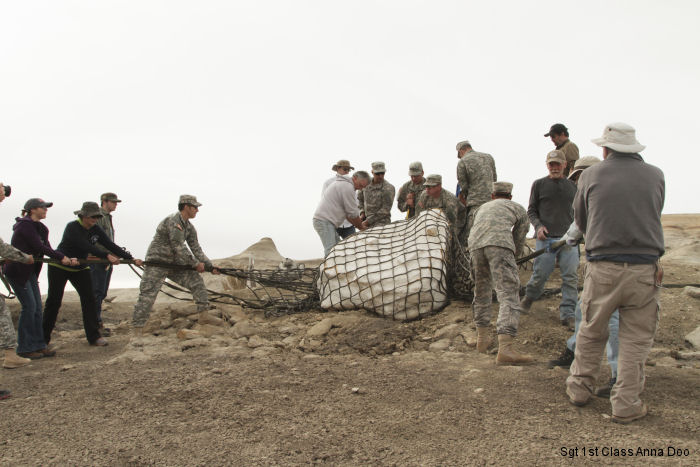US Army, October 30, 2015 - FARMINGTON, N.M. By Sgt 1st Class Anna Doo - Aviators, Infantrymen and Transportation Soldiers of the New Mexico Army National Guard assisted the New Mexico Museum of Natural History and Science (NMMNHS) with extracting fossils of two Pentaceratops dinosaur skulls from the badlands of New Mexico.
An adult Pentaceratops skull and juvenile fossil remains were airlifted via multiple Black Hawk sling loads Oct. 29 following a day of preparation of the loads.
The baby Pentaceratops is the first ever unearthed according to Dr. Spencer Lucas, Chief Curator of the NMMNHS.
“This ranks very high in the importance of Pentaceratops discoveries because it is the first baby skeleton, including the skull, ever recovered, and one of less than 10 adult Pentaceratops skulls unearthed,” Lucas said.
The discoveries occurred in 2011, beginning with the baby dinosaur found by Amanda Cantrell, NMMNHS Geoscience Collections Manager, in the Bisti/De-na-zin Wilderness Area south of Farmington, N.M. The adult was laying approximately 10 miles away in the Ah-shi-sle-pah Wilderness Study Area and was found two years later by Dr. Robert Sullivan, NMMNHS Research Associate. The two fossils would be painstakingly uncovered over the next few years and encased in plaster casts ready to be transported to the museum for study and display.
The Wilderness Area designations come with some rules that must be adhered to, including no mechanized vehicles on the land. The museum personnel estimated that each of the fossils, when encased in plaster, weighed three-quarters to one ton each. Airlifting the jackets was deemed the method of minimal impact to the wilderness to relocate the remains. Following nearly a year of planning, preparation and collaboration among the NMMNHS, NMNG, New Mexico Department of Cultural Affairs and the U.S. Bureau of Land Management which oversees the land area, the day arrived to prepare the fossils for airlift.
Two teams of qualified, capable Infantry Soldiers trekked the badlands to the site of each Pentaceratops on October 28 with NMMNHS personnel, volunteers and BLM professionals. The task for the day was to flip over the jacketed fossils into sling load cargo nets, hitting a target of at least 75 percent of the load being perfectly centered in the net. Following this task, the riggers would secure the net around the load, tie it up properly, check, check and recheck, and then hike back out of the wilderness. Flipping the 65 million-year-old dinosaurs proved to be much more challenging than originally guessed due to the sheer weight of the jackets as well as the moisture that had seeped into the undersides of two of the plaster casts.
The team at the baby Pentaceratops was able to flip over the skull in two attempts. They used a hand-controlled jack to ratchet up one side, slipped in blocks of wood to brace, and repeated until it was at an angle they could use their collective strength to tip the plaster cast onto the cargo net.
“The process, since it was an unconventional load, took some different planning,” said Staff Sgt. Jonathon Velarde, site leader at the Bisti location from Headquarters and Headquarters Company, 1st Battalion, 200th Infantry. “We had the right personnel here and were able to brainstorm together. There was never really a set way that we had. We knew once we got in there we’d take a look at everything and figure out the best option. My favorite part was getting the jackets onto the sling loads. That was something we hadn’t had experience with and we knew it was going to be a difficult process. That was our biggest hurdle. Once we got past that we knew we had the capability to do everything else that we needed to.”
Following nearly four hours of this ratchet up, block and brace, ratchet up, block and brace process, the jacketed skeletal remains of the baby Pentaceratops was finally flipped over onto the positioned net.
However, the water damage to the plaster cast proved to be too great and the load was deemed unsafe for aerial lift.
The juvenile skull was successfully airlifted on Oct. 29, by a Company C, 1st Battalion, 171st Aviation, UH-60 Black Hawk crew consisting of pilots Maj. Daniel Purcell and Capt. Kevin Doo, and crew chiefs Sgt. 1st Class Dennis Cahill and Sgt. Saul Monarez. As the helicopter began to descend within reach of 1-200 Infantry Soldiers Sgt. Bryan Haworth and Spc. Alonzo Romero, they stood fast prepared to attach the valuable cargo. Dust engulfed the infantrymen from the rotor wash, but they were able to hook on the load and quickly move to a safe distance.
“I was a little worried at first but the actual hookup went pretty flawless,” Haworth said. “When I saw it headed off to the drop zone it was nice to see it fly and not just drop. That was definitely a confidence booster. Moving dinosaur bones by airlift is unheard of; it’s a once-in-a-lifetime opportunity.”
Once attached, the pilots began to slowly ascend maintaining communication with the crew chiefs checking for any issues that could possibly arise. As they inched upward, the line securing the baby Pentaceratops skull became taught and eventually the dinosaur became airborne. According to Purcell, the jacket weighed close to 4,500 pounds, more than double the initial estimate. He said that aviators, they are well versed in picking up loads of 500-2,000 pounds and are also skilled in their aircraft’s capability and limits. Chief Warrant Officer 5 Dave Burrell, one of the two pilots at the adult skull pickup site, said that jacket weighed close to 5,500 pounds and they were unable to pick it up on the first attempt. The crew flew until they burnt off some fuel lightening the aircraft itself in order to lift such a hefty, unconventional load.
Purcell said cargo that heavy causes a structural strain as well as forces the Black Hawk engines to work at maximum capacity and capability resulting in a very small safety margin.
Purcell also spoke to the trust and confidence he has in the ability of the Infantrymen on the ground to properly prepare the load for airlift. “It’s very comfortable knowing those guys are out there, that’s why we asked for them,” he said. “They are professionals, they know what they’re doing, and we feel more comfortable picking up the load knowing it’s secure and it’s going to stay in place when we pick it up and in route.”
The adult skull located at the Ah-shi-sle-pah site was not without its own challenges in addition to weighing 5,500 lbs. According to Sgt. Sam Fischer, a team leader with Co. B, 1-200 Infantry, the jacket was resting in a sticky mud pit and the lack of tools appropriate for the task turned a hard situation into an almost impossible situation. Maj. Ali Dipour, battalion operations officer with HHC, 1-200 Infantry, echoed his sentiments adding that it was challenging not being able to see what they were working with until they arrived. However, teamwork, ingenuity, flexibility, grit and fortitude over nine hours of work inched the two and three-quarter tons block up and out of the depression it was laying in literally flipping it up a hill.
“You can tell [the BLM workers] have been able to work around unusual things with minimal tools and they know how to kind of jerry rig things pretty well,” said Dipour, speaking to the collaboration of the multiple agencies.
Covered in mud, but full of determination to achieve success, the team of nine Soldiers returned the morning of the sling load well before dawn to finalize preparing the jacket for airlift. Little did they know they had just turned over an oddly-shaped plaster cast weighing two and half times what they had originally thought.
Fischer summed up the team’s achievement by saying, “I think we came together really well after struggling so hard for one day and being out there for nine hours. We came back with a different mindset and things got done a lot quicker.”
The airlift of the adult skull occurred just after the airlift of the baby Pentaceratops by the crew of pilots Burrell and 1st Lt. James Raschel and crew chiefs Sgt. 1st Class Noah Berg and Staff Sgt. Nathan Schmidt. Traveling approximately 15 miles, the weight of the skull taxed the aircraft, but the skills of the crew delivered it safely to the drop zone next to its slightly smaller fellow fossil.
At the drop zone, ready to guide the aircraft and the loads to the ground, were a group of seven Infantrymen who had spent the previous day working hand-in-hand with the NMMNHS, BLM and fellow Soldiers to flip over the baby dinosaur. Watching the Black Hawks fly in with the dinosaur-laden sling loads was exhilarating for them.
“I was stressed!” exclaimed Sgt. Joshua Cunningham, an Infantryman with Company B. “After all the rigging we had to do the day before. But it was nice. It was nice and successful and that’s all that matters.”
He went on to add that the success was due in large part to their training and ability to set up the loads properly. “If we just went out there and threw nets on it, there was a huge possibility that there would have been some huge accidents,” he said.
But there were no accidents, no safety issues, and the two Pentaceratops skulls were loaded and secured onto a waiting trailer by M984 HEMMT (Heavy Expanded Mobility Tactical Truck) wrecker by Soldiers with the 1116th Transportation Company. Staff Sgt. Noe Amador and Sgt. James Ray drove the precious cargo to the NMMNHS in Albuquerque, N.M. Upon arrival, 1st Lt. Jerome Bustamante, Staff Sgt. Dargin Chavez and Staff Sgt. Andrew Houlton worked to lift the plaster casts off the trailer and secure them at the museum.
“The mission went really well and it was good training for the traditional Soldiers,” said Bustamante, a platoon leader with the 1116th. “The mission was accomplished and everyone was safe. We were able to really show the capabilities of the National Guard as far as our air assets, the Infantry piece as far as them having to go out there and rig it, and our transportation assets as far as being able to move it, as well as working with the civilians and the general public.”
The dinosaur bones are now safely housed at the NMMNHS and paleontology staff will work to remove the plaster casts, clean and stabilize the fossils. They will be put on display for the public to view as well as be used for research. Many of the Soldiers involved in the civil-military community support project said they will visit the museum in order to see the Pentaceratops fossils they helped excavate and deliver.
Haworth said, “I definitely will visit. I’ll take the whole family and point to it and say, ‘I did that’.”
Mission complete.
An adult Pentaceratops skull and juvenile fossil remains were airlifted via multiple Black Hawk sling loads Oct. 29 following a day of preparation of the loads.
The baby Pentaceratops is the first ever unearthed according to Dr. Spencer Lucas, Chief Curator of the NMMNHS.
“This ranks very high in the importance of Pentaceratops discoveries because it is the first baby skeleton, including the skull, ever recovered, and one of less than 10 adult Pentaceratops skulls unearthed,” Lucas said.
The discoveries occurred in 2011, beginning with the baby dinosaur found by Amanda Cantrell, NMMNHS Geoscience Collections Manager, in the Bisti/De-na-zin Wilderness Area south of Farmington, N.M. The adult was laying approximately 10 miles away in the Ah-shi-sle-pah Wilderness Study Area and was found two years later by Dr. Robert Sullivan, NMMNHS Research Associate. The two fossils would be painstakingly uncovered over the next few years and encased in plaster casts ready to be transported to the museum for study and display.
The Wilderness Area designations come with some rules that must be adhered to, including no mechanized vehicles on the land. The museum personnel estimated that each of the fossils, when encased in plaster, weighed three-quarters to one ton each. Airlifting the jackets was deemed the method of minimal impact to the wilderness to relocate the remains. Following nearly a year of planning, preparation and collaboration among the NMMNHS, NMNG, New Mexico Department of Cultural Affairs and the U.S. Bureau of Land Management which oversees the land area, the day arrived to prepare the fossils for airlift.
Two teams of qualified, capable Infantry Soldiers trekked the badlands to the site of each Pentaceratops on October 28 with NMMNHS personnel, volunteers and BLM professionals. The task for the day was to flip over the jacketed fossils into sling load cargo nets, hitting a target of at least 75 percent of the load being perfectly centered in the net. Following this task, the riggers would secure the net around the load, tie it up properly, check, check and recheck, and then hike back out of the wilderness. Flipping the 65 million-year-old dinosaurs proved to be much more challenging than originally guessed due to the sheer weight of the jackets as well as the moisture that had seeped into the undersides of two of the plaster casts.
The team at the baby Pentaceratops was able to flip over the skull in two attempts. They used a hand-controlled jack to ratchet up one side, slipped in blocks of wood to brace, and repeated until it was at an angle they could use their collective strength to tip the plaster cast onto the cargo net.
“The process, since it was an unconventional load, took some different planning,” said Staff Sgt. Jonathon Velarde, site leader at the Bisti location from Headquarters and Headquarters Company, 1st Battalion, 200th Infantry. “We had the right personnel here and were able to brainstorm together. There was never really a set way that we had. We knew once we got in there we’d take a look at everything and figure out the best option. My favorite part was getting the jackets onto the sling loads. That was something we hadn’t had experience with and we knew it was going to be a difficult process. That was our biggest hurdle. Once we got past that we knew we had the capability to do everything else that we needed to.”
Following nearly four hours of this ratchet up, block and brace, ratchet up, block and brace process, the jacketed skeletal remains of the baby Pentaceratops was finally flipped over onto the positioned net.
However, the water damage to the plaster cast proved to be too great and the load was deemed unsafe for aerial lift.
The juvenile skull was successfully airlifted on Oct. 29, by a Company C, 1st Battalion, 171st Aviation, UH-60 Black Hawk crew consisting of pilots Maj. Daniel Purcell and Capt. Kevin Doo, and crew chiefs Sgt. 1st Class Dennis Cahill and Sgt. Saul Monarez. As the helicopter began to descend within reach of 1-200 Infantry Soldiers Sgt. Bryan Haworth and Spc. Alonzo Romero, they stood fast prepared to attach the valuable cargo. Dust engulfed the infantrymen from the rotor wash, but they were able to hook on the load and quickly move to a safe distance.
“I was a little worried at first but the actual hookup went pretty flawless,” Haworth said. “When I saw it headed off to the drop zone it was nice to see it fly and not just drop. That was definitely a confidence booster. Moving dinosaur bones by airlift is unheard of; it’s a once-in-a-lifetime opportunity.”
Once attached, the pilots began to slowly ascend maintaining communication with the crew chiefs checking for any issues that could possibly arise. As they inched upward, the line securing the baby Pentaceratops skull became taught and eventually the dinosaur became airborne. According to Purcell, the jacket weighed close to 4,500 pounds, more than double the initial estimate. He said that aviators, they are well versed in picking up loads of 500-2,000 pounds and are also skilled in their aircraft’s capability and limits. Chief Warrant Officer 5 Dave Burrell, one of the two pilots at the adult skull pickup site, said that jacket weighed close to 5,500 pounds and they were unable to pick it up on the first attempt. The crew flew until they burnt off some fuel lightening the aircraft itself in order to lift such a hefty, unconventional load.
Purcell said cargo that heavy causes a structural strain as well as forces the Black Hawk engines to work at maximum capacity and capability resulting in a very small safety margin.
Purcell also spoke to the trust and confidence he has in the ability of the Infantrymen on the ground to properly prepare the load for airlift. “It’s very comfortable knowing those guys are out there, that’s why we asked for them,” he said. “They are professionals, they know what they’re doing, and we feel more comfortable picking up the load knowing it’s secure and it’s going to stay in place when we pick it up and in route.”
The adult skull located at the Ah-shi-sle-pah site was not without its own challenges in addition to weighing 5,500 lbs. According to Sgt. Sam Fischer, a team leader with Co. B, 1-200 Infantry, the jacket was resting in a sticky mud pit and the lack of tools appropriate for the task turned a hard situation into an almost impossible situation. Maj. Ali Dipour, battalion operations officer with HHC, 1-200 Infantry, echoed his sentiments adding that it was challenging not being able to see what they were working with until they arrived. However, teamwork, ingenuity, flexibility, grit and fortitude over nine hours of work inched the two and three-quarter tons block up and out of the depression it was laying in literally flipping it up a hill.
“You can tell [the BLM workers] have been able to work around unusual things with minimal tools and they know how to kind of jerry rig things pretty well,” said Dipour, speaking to the collaboration of the multiple agencies.
Covered in mud, but full of determination to achieve success, the team of nine Soldiers returned the morning of the sling load well before dawn to finalize preparing the jacket for airlift. Little did they know they had just turned over an oddly-shaped plaster cast weighing two and half times what they had originally thought.
Fischer summed up the team’s achievement by saying, “I think we came together really well after struggling so hard for one day and being out there for nine hours. We came back with a different mindset and things got done a lot quicker.”
The airlift of the adult skull occurred just after the airlift of the baby Pentaceratops by the crew of pilots Burrell and 1st Lt. James Raschel and crew chiefs Sgt. 1st Class Noah Berg and Staff Sgt. Nathan Schmidt. Traveling approximately 15 miles, the weight of the skull taxed the aircraft, but the skills of the crew delivered it safely to the drop zone next to its slightly smaller fellow fossil.
At the drop zone, ready to guide the aircraft and the loads to the ground, were a group of seven Infantrymen who had spent the previous day working hand-in-hand with the NMMNHS, BLM and fellow Soldiers to flip over the baby dinosaur. Watching the Black Hawks fly in with the dinosaur-laden sling loads was exhilarating for them.
“I was stressed!” exclaimed Sgt. Joshua Cunningham, an Infantryman with Company B. “After all the rigging we had to do the day before. But it was nice. It was nice and successful and that’s all that matters.”
He went on to add that the success was due in large part to their training and ability to set up the loads properly. “If we just went out there and threw nets on it, there was a huge possibility that there would have been some huge accidents,” he said.
But there were no accidents, no safety issues, and the two Pentaceratops skulls were loaded and secured onto a waiting trailer by M984 HEMMT (Heavy Expanded Mobility Tactical Truck) wrecker by Soldiers with the 1116th Transportation Company. Staff Sgt. Noe Amador and Sgt. James Ray drove the precious cargo to the NMMNHS in Albuquerque, N.M. Upon arrival, 1st Lt. Jerome Bustamante, Staff Sgt. Dargin Chavez and Staff Sgt. Andrew Houlton worked to lift the plaster casts off the trailer and secure them at the museum.
“The mission went really well and it was good training for the traditional Soldiers,” said Bustamante, a platoon leader with the 1116th. “The mission was accomplished and everyone was safe. We were able to really show the capabilities of the National Guard as far as our air assets, the Infantry piece as far as them having to go out there and rig it, and our transportation assets as far as being able to move it, as well as working with the civilians and the general public.”
The dinosaur bones are now safely housed at the NMMNHS and paleontology staff will work to remove the plaster casts, clean and stabilize the fossils. They will be put on display for the public to view as well as be used for research. Many of the Soldiers involved in the civil-military community support project said they will visit the museum in order to see the Pentaceratops fossils they helped excavate and deliver.
Haworth said, “I definitely will visit. I’ll take the whole family and point to it and say, ‘I did that’.”
Mission complete.
See also |
Black Hawk in








